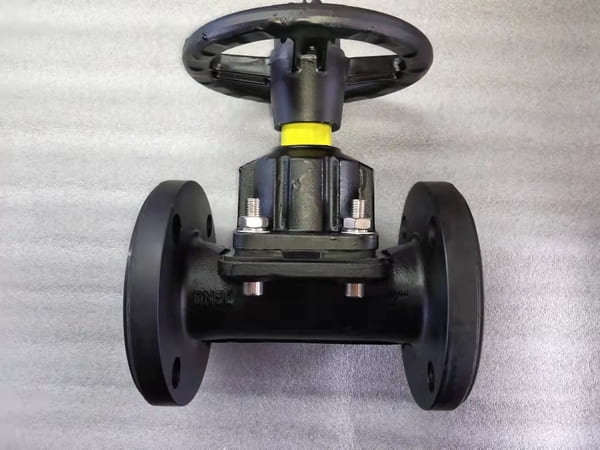The structure of the diaphragm valve is very different from the general valve. It relies on a soft rubber diaphragm or plastic diaphragm to control the fluid movement. Its working principle is shown in the figure below. Commonly used diaphragm valve materials are divided into cast iron, cast steel, stainless steel , and plastic .
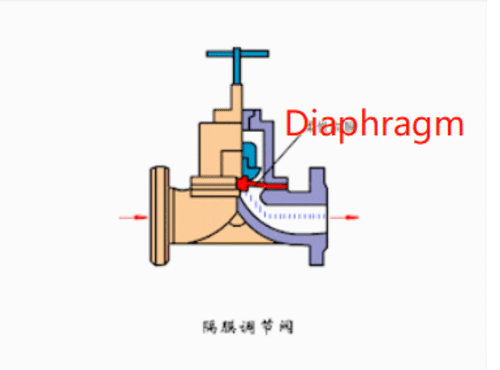
Introduction Diaphragm valve
The structure of the diaphragm valve is very different from the general valve. It is a new type of valve and a special form of cut-off valve. Its opening and closing part is a diaphragm made of soft material. The inner cavity of the cover and the driving part are separated and are now widely used in various fields. Commonly used diaphragm valves include rubber-lined diaphragm valves, fluorine-lined diaphragm valves, unlined diaphragm valves, and plastic diaphragm valves.
Diaphragm valve is equipped with a flexible diaphragm or combined diaphragm in the valve body and bonnet, and its closing part is a compression device connected with the diaphragm. The valve seat can be weir-shaped, or it can be a pipe wall that passes through the flow channel. The advantage of the diaphragm valve is that its operating mechanism is separated from the medium passage, which not only ensures the purity of the working medium, but also prevents the possibility of the medium in the pipeline from impacting the working parts of the operating mechanism. In addition, there is no need to use any form of separate seal at the valve stem, unless it is used as a safety facility in the control of hazardous media. In the diaphragm valve, since the working medium is only in contact with the diaphragm and the valve body, both of which can use a variety of different materials, the valve can ideally control a variety of working media, especially suitable for chemically corrosive or suspended particles medium. The working temperature of the diaphragm valve is usually limited by the materials used in the diaphragm and the valve body lining, and its working temperature range is approximately -50 to 175°C. The diaphragm valve has a simple structure, consisting of only three main parts, the valve body, the diaphragm and the valve cover assembly. The valve is easy to quickly disassemble and repair, and the replacement of the diaphragm can be completed on site and in a short time.
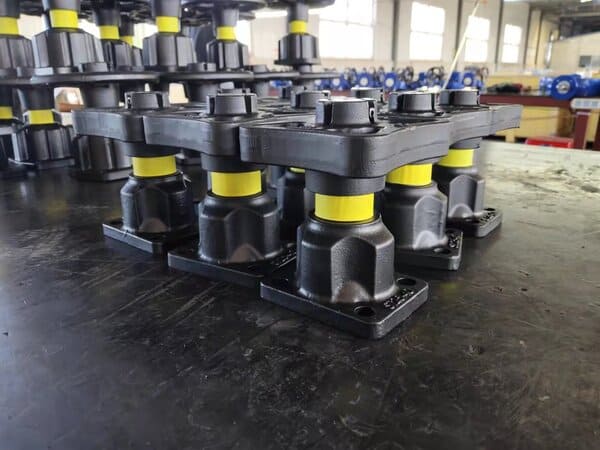
Material classification
| Lining material (code name) | Operating temperature(℃) | Applicable medium |
| Hard rubber(NR) | -10~85 | Hydrochloric acid, 30% sulfuric acid, 50% hydrofluoric acid, 80% phosphoric acid, alkali, salts, metal plating solution, sodium hydroxide, potassium hydroxide, neutral salt solution, 10% sodium hypochlorite, warm chlorine, ammonia, most Alcohols, organic acids and aldehydes, etc. |
| Soft Rubber (BR) | -10~85 | Cement, clay, cinder ash, granular fertilizers, solid fluids with strong abrasiveness, thick viscous liquids of various concentrations, etc. |
| Fluororubber(CR) | -10~85 | Animal and vegetable oils, lubricants, and corrosive muds with a wide range of pH values, etc. |
| Butyl rubber(HR) | -10~120 | Organic acids, alkalis and hydroxide compounds, inorganic salts and inorganic acids, elemental gas alcohols, aldehydes, ethers, ketones, etc. |
| Polyvinylidene fluoride propylene plastic (FEP) | ≤150 | In addition to molten alkali metals, elemental fluorine and aromatic hydrocarbons, hydrochloric acid, sulfuric acid, aqua regia, organic acids, strong oxidants, alternating concentrated and dilute acids, alternating acid and alkali, and various organic solvents, etc. |
| Polyvinylidene fluoride plastic (PVDF) | ≤100 | |
PTFE and ethylene copolymer (ETFE) | ≤120 | |
Fusible PTFE Plastic (PFA) | ≤180 | |
Polychlorotrifluoroethylene plastic (PCTFE) | ≤120 | |
| enamel | ≤100 Avoid sudden changes in temperature | Other low-grade corrosive media except hydrofluoric acid, concentrated phosphoric acid and strong alkali |
| Cast iron without lining | Use temperature according to diaphragm valveMaterial set | Non-corrosive medium |
| Stainless steel unlined | General corrosive medium |
Installation and maintenance
①Before installing the diaphragm valve, carefully check whether the operating conditions of the pipeline are consistent with the scope of use specified by the valve, and clean the inner cavity to prevent dirt from jamming or damaging the sealing parts.
②Do not apply grease or oil on the surface of the rubber lining and the rubber diaphragm to prevent the rubber from swelling and affecting the service life of the diaphragm valve.
③The hand wheel or transmission mechanism is not allowed to be used for lifting, and collision is strictly prohibited.
④ When manually operating the diaphragm valve, do not use auxiliary levers to prevent excessive torque from damaging the drive components or sealing parts.
⑤Diaphragm valves should be stored in a dry and ventilated room. Stacking is strictly prohibited. The channels at both ends of the stock diaphragm valve must be sealed, and the opening and closing parts should be in a slightly open state.
| Failure | Cause | Method |
| Handwheel operation is not flexible | 1. Stem buckling 2. Thread damage | 1. Replace the valve stem 2. Trim the threads and add lubricating oil |
| The valve cannot be opened and closed automatically when it is pneumatic. | 1,Air pressure is too low 2. The spring preload is too large3. The rubber diaphragm is damaged. | 1,Increase air supply pressure 2. Reduce spring preload 3. Replace the diaphragm |
| Leakage at the junction of valve body and bonnet | 1. Loose connection bolts 2. The lining of the valve body is broken. | 1,Tighten the connecting bolt 2. Replace the valve body |
Structure classification
Diaphragm valves can be divided into six types according to the structure: Weir type, DC type, cut-off type, straight-through type, gate type and right-angle type; the connection form is usually flange connection; according to the driving mode, it can be divided into manual, electric and pneumatic There are three types, of which pneumatic drives are divided into three types: normally open, normally closed and reciprocating.
weir type
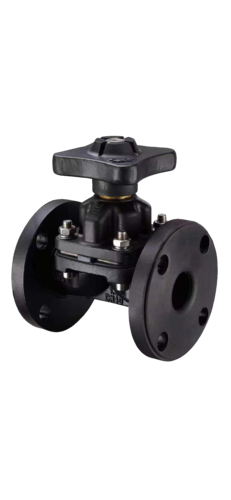
Its structure is shown in the figure below. It can be seen from the figure that the valve body is lined. Diaphragm valve body lining is to better exert its corrosion resistance characteristics.
This kind of structure, in addition to the straight-through type, can also be made into a right-angle type.
Straight-through type
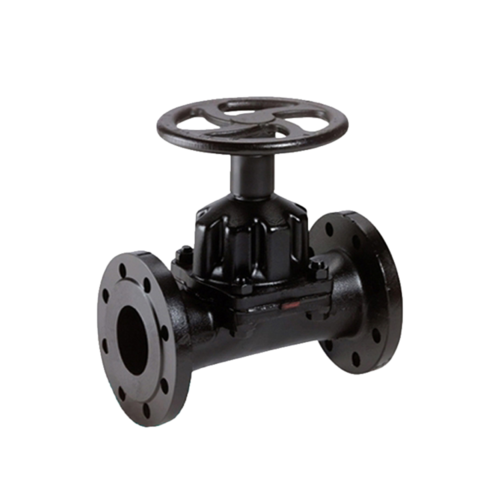
The structure and shape of the straight-through type are similar to that of the globe valve
This type of diaphragm valve has a larger fluid resistance than a weir type diaphragm valve, but it has a large sealing area and good sealing performance, which is suitable for pipelines with high vacuum.
Straight-flow type
The structure of the direct current type is similar to that of the gate valve.
The ram-type diaphragm valve has the least fluid resistance and is suitable for conveying viscous materials.
Diaphragm materials are commonly used natural rubber, neoprene, nitrile rubber, isobutyl rubber, fluorinated rubber and polyfluoroethylene propylene (F46).
The disadvantage of the diaphragm valve is that the pressure resistance is not high, generally within 6kgf/cm2 (0.6MPa); the temperature resistance is also limited by the diaphragm, generally only 60~80℃, the highest (fluorine rubber) does not exceed 180℃ .
Features and selection of diaphragm valve
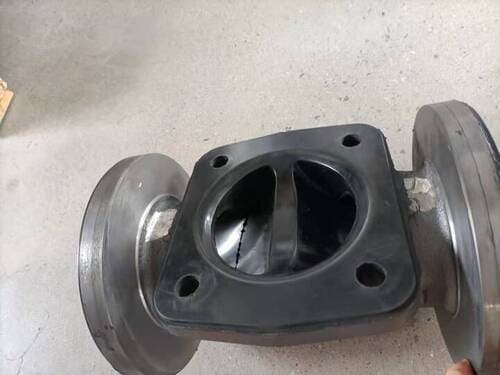
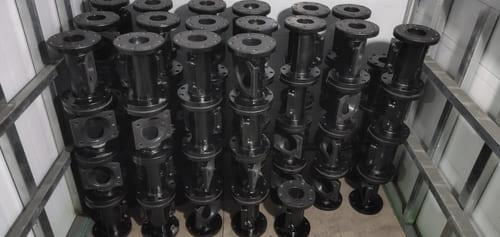
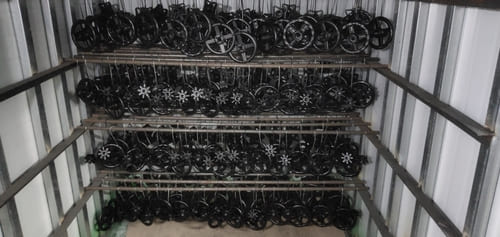
(1) The fluid resistance is small.
(2) It can be used for the medium containing hard suspended solids; since the medium only contacts the valve body and the diaphragm, there is no need for stuffing box, there is no stuffing box leakage problem, and there is no possibility of corrosion to the valve stem.
(3) Suitable for corrosive, viscous, and slurry media.
(4) Cannot be used in high pressure occasions.
(5) The recommended use range of diaphragm material is as follows:
| Diaphragm material(Codename) | Oppration Temperature ℃ | Application Medium |
| Butyl rubber (Grade B) | -40~100 | Good acid and alkali resistance (85% sulfuric acid, hydrochloric acid, hydrofluoric acid, phosphoric acid, caustic alkali and various esters) |
| Natural rubber (Q grade) | -50~100 | Purified water, inorganic salts, diluted inorganic acids, etc. |
| Polyfluoroethylene propylene (FEP or F46) | ≤150 | Various concentrations of sulfuric acid, hydrofluoric acid, aqua regia, high-temperature concentrated nitric acid, various organic acids and strong alkalis, strong oxidants, alternating concentrated acids and dilute acids, alternating acids and alkalis, various organic solvents and other strong corrosive media |
| Soluble polytetrafluoroethylene (PFA) | ≤180 |

